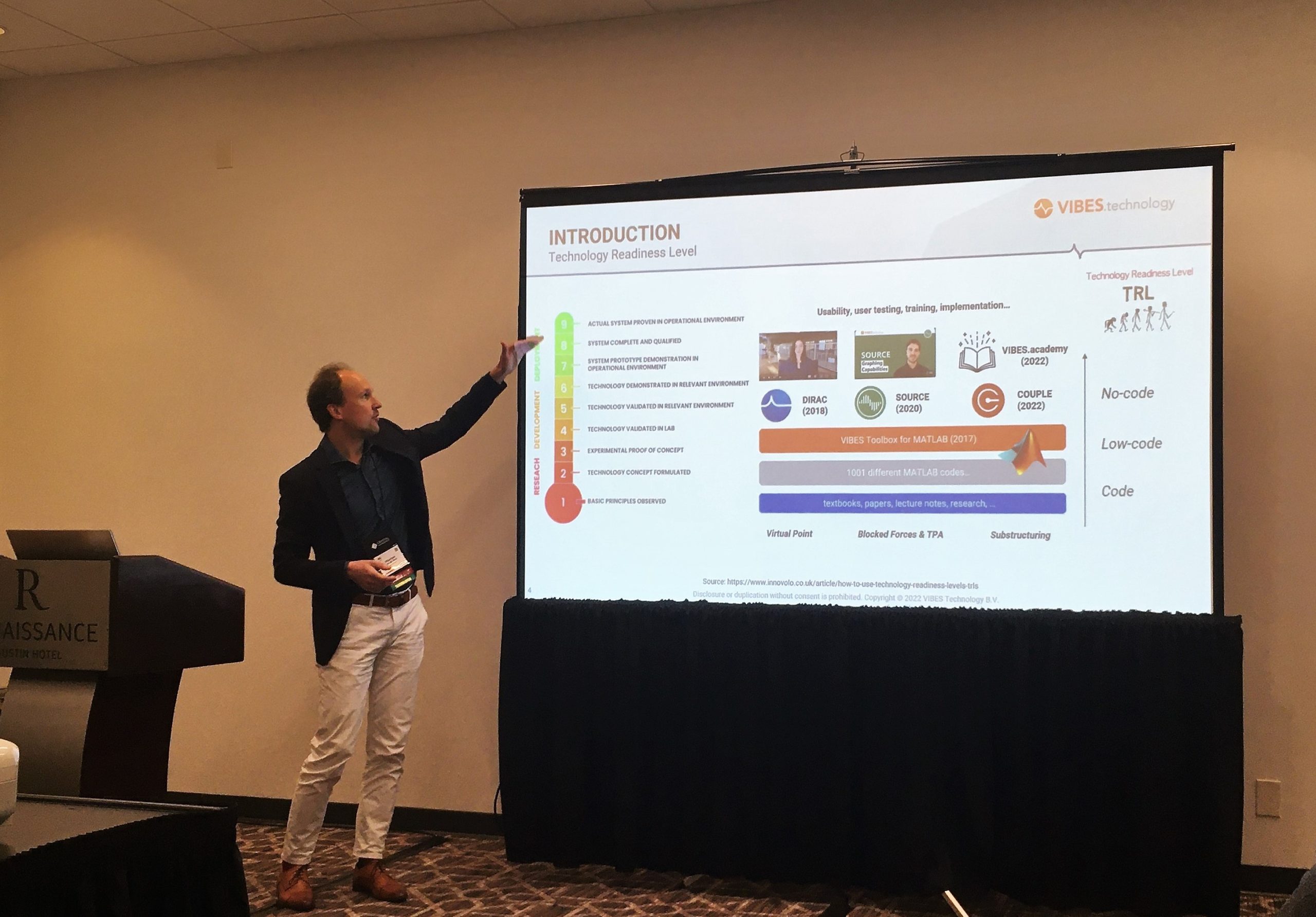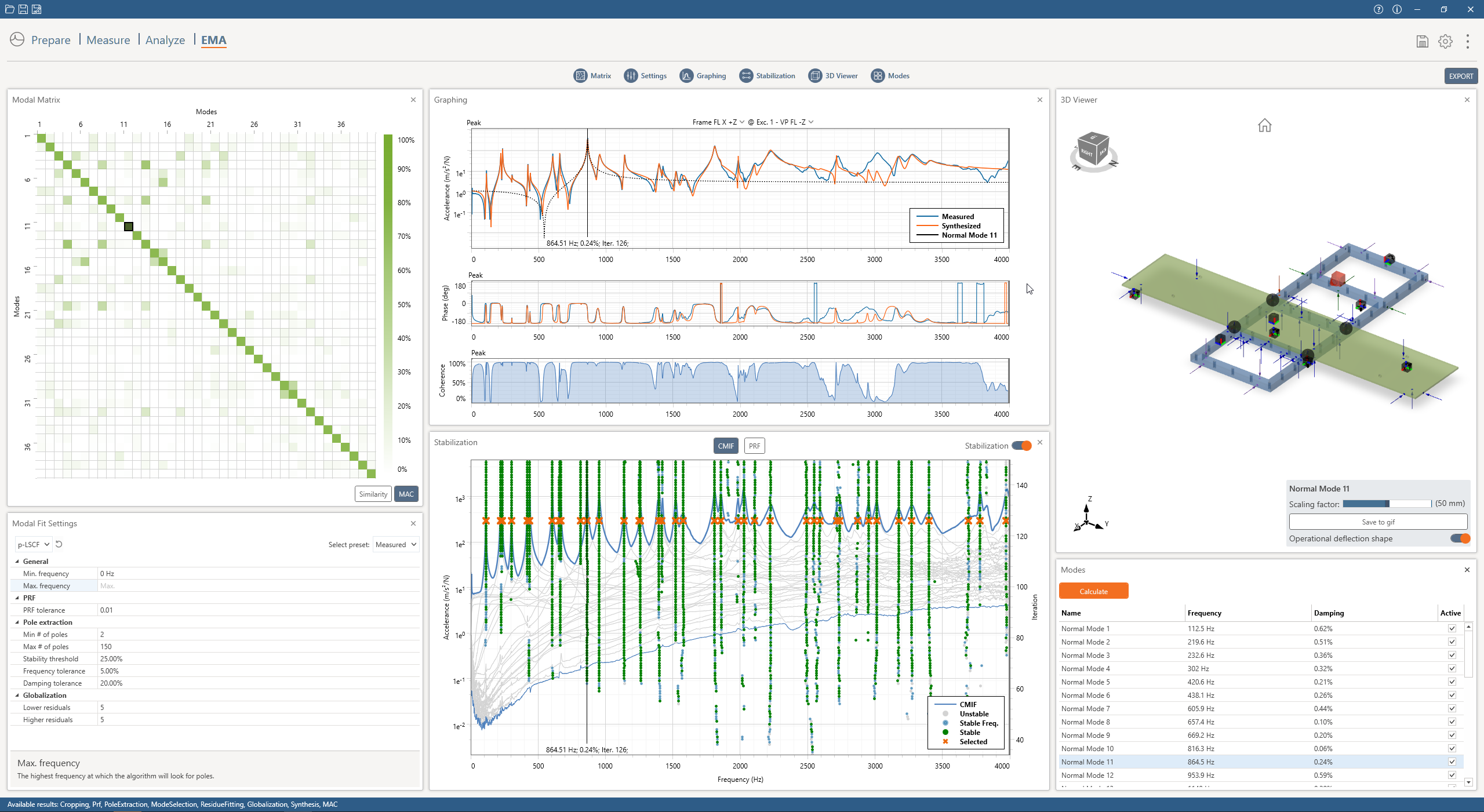VIBES at IMAC Conference 2023
09 March 2023
The International Modal Analysis Conference (IMAC) is a yearly gathering of around 600 engineers, researchers and vendors active in the field of experimental mechanics. Specifically, it is seen as somewhat of the birthplace of Dynamic Substructuring technologies, as much of the pioneering research has been presented here.
Organized by the Society of Experimental Mechanics, IMAC is held yearly in the sunnier and more southern United States, commonly known as “the friendly conference”. VIBES has actively participated at IMAC since the very start in 2017, visiting conferences in Orlando, Houston and San Francisco. This year’s conference took place in the lively city of Austin, Texas. Maarten van der Seijs and Ron Reichart went down there to represent VIBES this year and engage in all the technical and non-technical activities.
Tutorial on Dynamic Substructuring
Dynamic Substructuring is a fundamental topic built upon in many presenters’ technical papers. For newcomers, it is necessary to become familiar with the method’s basics and notations. This year again, Maarten van der Seijs and professor Daniel Rixen from Technische Universität München were asked to give an introduction tutorial on Experimental Dynamic Substructuring and Joint Identification. The substructuring basics were introduced by Maarten to a packed room of more than 80 attendees, from academia as well as industry. Daniel Rixen continued with an overview of several joint identification strategies. We finished off with a quick demonstration in DIRAC on how to easily extract dynamic stiffness from a typical rubber bushing as found in automotive engineering.
On popular request, all slide material in PDF can be found here:
- Tutorial on Experimental Substructuring – VIBES.technology, Maarten van der Seijs
- Application to Joint Identification – TU München, Daniel Rixen
Collaboration with Hyundai
Ron Reichart had the pleasure of presenting an application paper reviewing the impressive achievements of the long collaboration with Hyundai Motor Company. The paper, entitled How Virtual Points, Component TPA and FBS Disrupted the Vehicle Suspension Development Process, details on a highly innovative process improvement to minimize tire noise in an early stage of product design. Ron specifically focused on the use of a Genetic Algorithm to find optimal suspension configurations. This process was made possible because of previous successful steps in the creation of a reliable vibration model, using Virtual Points, Blocked Forces and substructuring technology; see also here. Ron nicely explained all this in front of an audience of about 50 attendees.
The full paper is accessible here: How Virtual Points, Component TPA and FBS Disrupted the Vehicle Suspension Development Process – Ron Reichart, Munwhan Cho, David Song, Steven Klaassen.
SEM Round-Robin benchmark & VIBES software demos
The IMAC conference is also a place where so-called technical divisions convene, focusing on specific key research fields. VIBES is actively participating in the Technical Division for Dynamic Substructures. This division recently launched a new Round-Robin Benchmark Structure. This serves as a test bed for collaboration: every participating party has the opportunity to work on the same set of substructures, and to apply and validate substructuring-related methods of their choosing.
Maarten presented the VIBES contribution not in the form of a paper, but rather by means of live software demos in DIRAC, SOURCE and COUPLE. First, he started by motivating the need for “no-code” solutions, by means of the Technology Readiness Level (TRL). Early stages of conceptual research (TRL < 4) are often supported by “coded” approaches using rudimentary MATLAB/Python scripts. While maturing such concepts into readily applicable methods, it is warranted to develop “low-code” solutions, such as the VIBES Toolbox for MATLAB. However, to scale up towards industry adoption (TRL 6 to 9), it is important to entirely move away from coded approaches to solutions that can be fully operated from an easy-to-use graphical user interface. Our products DIRAC, SOURCE and COUPLE are the very embodiment of this high TRL level.
This initial motivation resonated well with the audience, who could very well relate to the challenges of maturing technology. Following up on this were three rapid de demonstrations of parts of the analysis in DIRAC (including a preview of the upcoming solution for Experimental Modal Analysis, see below), SOURCE and COUPLE. The COUPLE environment worked out particularly well to set up the various configurations with different wing substructures, as prescribed in this Round-Robin benchmark.
Next year’s IMAC will be held in Orlando (Florida) again. VIBES will be back with at least a follow-up on the Round-robin study, and likely some other technical papers.
Happy IMAC!
Starring:
Maarten van der Seijs
Maarten holds a PhD degree from the TU Delft on DS and is responsible for the technology within VIBES. He co-founded VIBES when he came back to Delft from BMW in Munich, where he did his PhD research.
Ron Reichart
Ron has a Master in structural dynamics and experimental analysis of dynamical systems. At the BMW Group, he constructed a Virtual Acoustic Prototype using TPA and DS techniques.





